Arts & Entertainment Community
Day Tripper | Flying high at the Museum of Flight
Recently, I read about a bead-covered jet that’s currently in residence at the Museum of Flight in Seattle. How is that possible? I guess it’s not that surprising it’s at the Museum of Flight, but why would someone spend the time, energy, and money required to cover a fighter jet with glass beads? Who would do that?
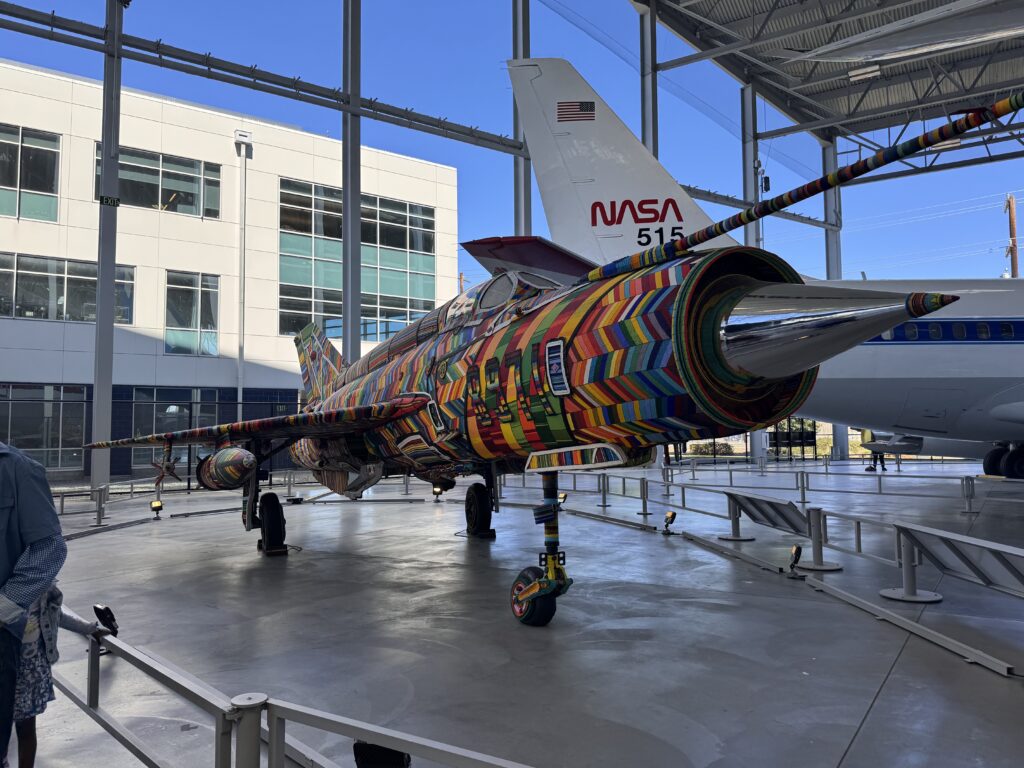
A bead-covered MiG jet at the Museum of Flight in Seattle. Photo by Mary Williams
MiG-21 Project
Known as the MiG-21 Project, it’s touted as an artistic collaboration of international artists and designers from Los Angeles and South Africa. The project’s tag line is: “A multimedia exhibit motivated by social responsibility and fueled by history.”
I had never heard of either South African artist Ralph Ziman or the MiG-21 Project, but I knew I wanted to learn more. The museum’s website describes the exhibit as “a multidisciplinary project transforming a decommissioned Cold-War-era, Soviet designed MiG-21 fighter jet into a stunning work of art entirely covered in tens of millions of colorful glass beads.”
Additionally, I learned that the jet is the culmination of a much larger project, The Weapons of Mass Production Trilogy. It includes original artwork, Afro-futuristic flight suits, photographs, videos, and other interactive exhibits.
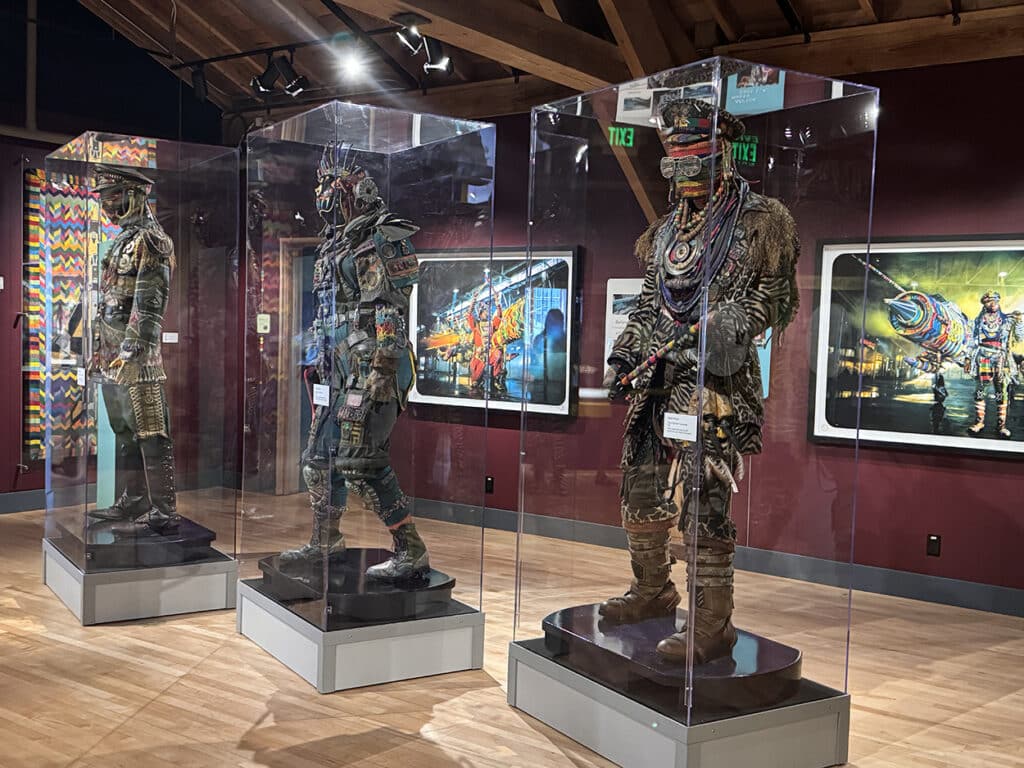
Afro-futuristic flight suits at the Museum of Flight in Seattle. Photo by Mary Williams
In order to better understand what you’re seeing, the exhibit displays graphics leading you through the evolution of The MiG-21 Project. While the work on the jet spanned five years, the entire Weapons of Mass Production Trilogy was a 12-year project. The trilogy tells the story of how the arms trade impacts global conflicts and the continued militarization of police forces around the world. It combines history, social awareness, cultural appreciation, and the healing power of creativity by celebrating Southern African beadwork.
My preliminary research provided one more very important fact. The MiG-21 jet will only be on display at the Museum through January 2026, so if I wanted to see it, or if you want to see it, time is of the essence. I definitely wanted to see it!
A day at the museum
In a perfect world, my granddaughters would love museums as much as I do. Only in my dreams. Since one of my older granddaughters, a talented crafter, was going to be visiting, I thought maybe I could convince her to go with me. I figured we’d spend an hour or so there and then move on to the waterfront or somewhere, probably in the big city, that she’d find more enjoyable.
Boy, did I underestimate the Museum of Flight. I have been there several times, but always for a meeting. I’d only seen the front part of the main building. Little did I know what lay beyond. In many ways, the museum is several museums within a museum. It was easy to spend most of a day there and still feel like I need to go back for more.
First, I’ll tell you that we both agree that our favorite exhibit in the museum is the beaded jet, our original destination. But even she confirmed there was a lot of other interesting stuff to see and learn about as well. It was easy to spend our entire day at the museum.
The jet itself is located at the farthest point in the farthest building, so it was just about the last thing we actually saw. There were, however, plenty of opportunities to learn more about the artists and their projects before we got to the jet.
There was a special section in the Red Barn (more about that later) that explained the entire project and the artisans who created it. It included many examples of the work of different artists as they applied beads to the weapons, but the actual MiG-21 itself is across the street at the back of the Aviation Pavilion.
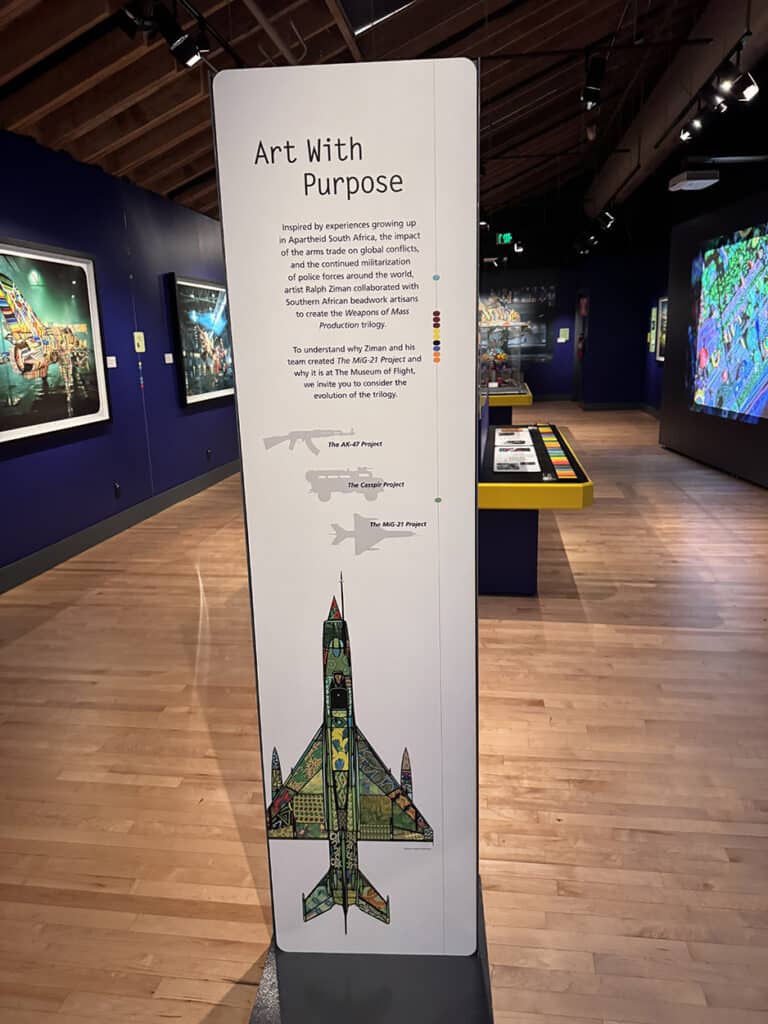
A sign at the Museum of Flight in Seattle explains the MiG Project. Photo by Mary Williams
We also learned that while the jet is the final element in the project, there was much more to see before we got there. It’s scattered throughout various sections of the museum, so it seemed important to get the lay of the land and plan our visit. We started by learning a bit more about the museum’s history and development.
Preserving the history of aviation
In 1964, a small group realized that important and historical artifacts representing the evolution of flight were being lost or destroyed.
To aid in preserving this history, they established the Pacific Northwest Aviation Historical Foundation. Their goal was to save important aircraft and related memorabilia and to educate the public about its significance. By 1965, the first official Museum of Flight exhibits were displayed in a 10,000-square-foot location that was empty at the post-World’s Fair Seattle Center. That worked until 1975, when the Port of Seattle agreed to a 99-year lease for the land on which the Boeing Field Red Barn now sits and development of that location began.
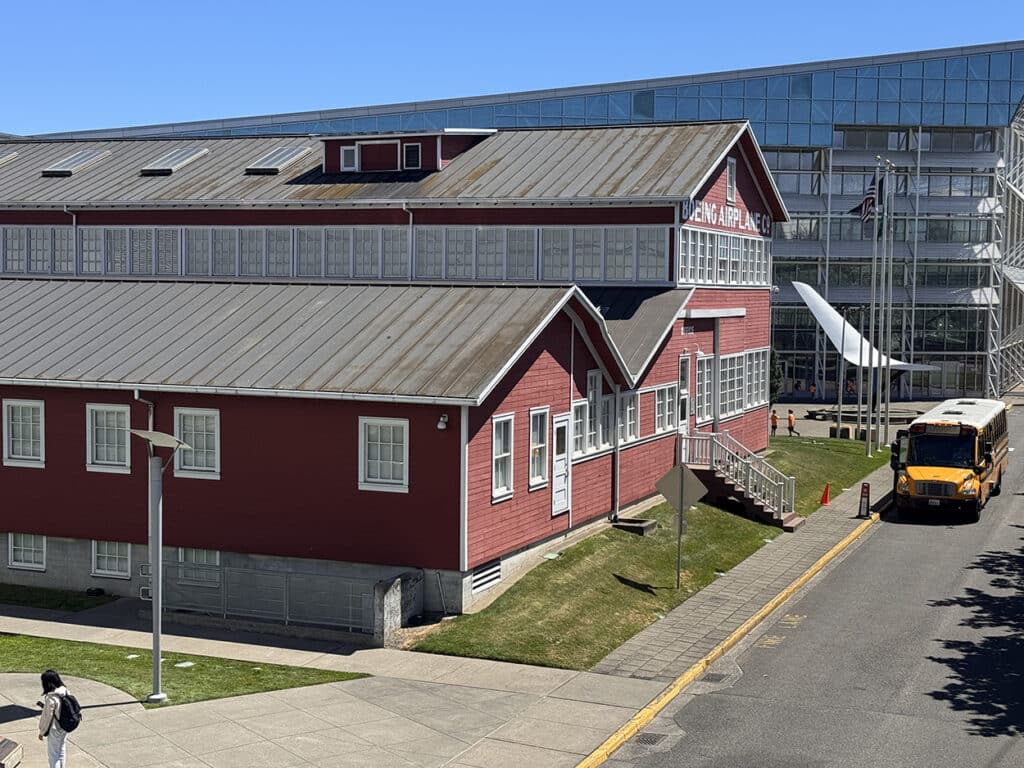
The Red Barn at the Seattle Museum of Flight. Photo by Mary Williams
In 1910, William Boeing purchased a balloon frame building on the banks of the Duwamish River to house construction of the yacht he was having built.

An exhibit at the Seattle Museum of Flight. Photo by Mary Williams
Boeing’s interest shifted from the sea to the air in 1916, and his Pacific Aero Products Company converted the building, by then known as the Red Barn, into engineering offices and a manufacturing plant. Its initial use was the construction of the company’s first airplane, the 1916 Boeing and Westervelt (B&W) aircraft. The firm changed its name to the Boeing Airplane Company in 1917.
Moving the Red Barn
In the wake of the temporary economic decline of the company in 1975, the facility fell largely into decay. The Port of Seattle bought the site. Just in the nick of time, with demolition imminent, placement on the National Historic Register saved it. With its site sold, the Red Barn had to be moved. It was barged down the Duwamish River and trucked to its current home. Restored in 1983, it became the first permanent location for the Museum of Flight.
The Red Barn now serves as a tribute to its parent company’s heritage. Included in its exhibits is the story of the transformation of the world’s largest airplane manufacturer from humble beginnings to what it is today.
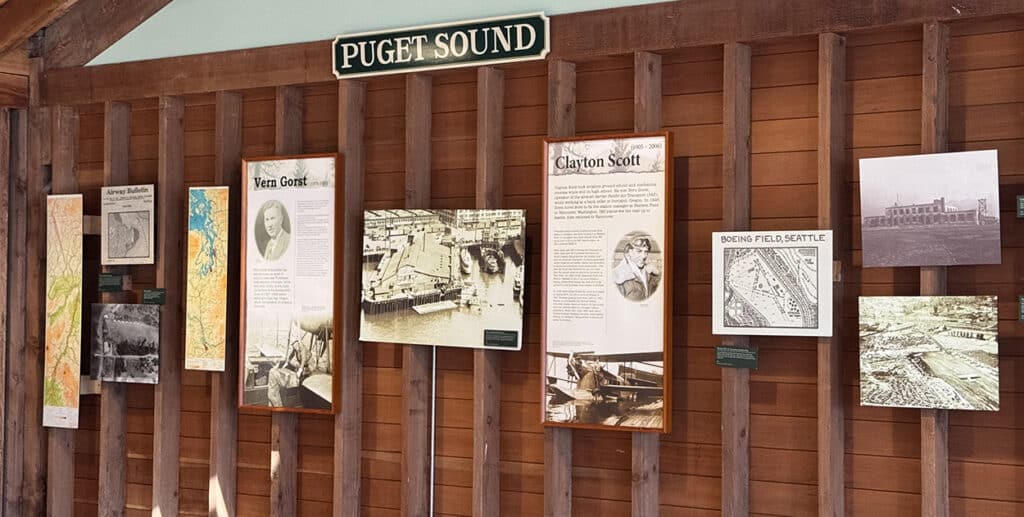
The history of the Boeing Co. Photo by Mary Williams
If you read Day Tripper even semi-regularly you know that my intention is to never (well hardly ever) recreate the wheel. If someone else has done the work, I am more than happy to give them credit for it and refer you to their previously published information.
In this case, I happened to stumble on a blog post written by Tony Bruno, a retired pilot and flight instructor, who lives in Kitty Hawk, N.C. If you are planning a visit to the museum, or are interested in aviation history, I’d suggest you peruse this resource. It is an absolute wealth of information.
Today, the museum comprises six distinct areas. Three of them are on the east side of Marginal Way: The T.A. Wilson Great Gallery, The William E. Boeing Red Barn, and the J. Elroy McCaw Personal Courage Wing. The West Campus, on the other side of the street, is made up of the Charles Simonyi Space Gallery, the Aviation Pavilion, and the Vietnam Veterans Memorial Park.
Where to first?
With our research behind us, and a tentative plan in place, we were ready to go.
The parking area is on the east side of Marginal Way. Entrance to the entire facility is adjacent to the lot.
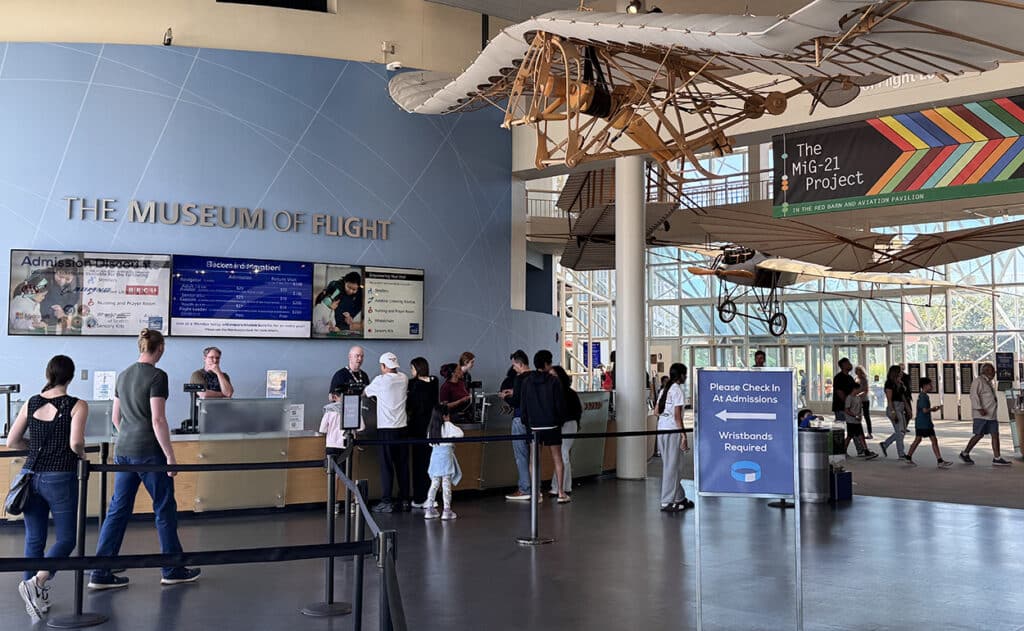
The entrance to the Seattle Museum of Flight. Photo by Mary Williams
As we entered the lobby, we were confronted with our first decision.
Admission to the museum is $29 for adults, $25 for seniors, and $21 for children 5-17. Children 4 or younger are free. If, as I did, you find that you haven’t budgeted enough time to see everything you want to, you can return a second day within the week at a reduced cost. Or you can apply the cost of your visit to an annual membership, which will allow you to stop by and visit as often as you’d like. Easy access off I-5 and convenient free parking makes this an affordable option. Several annual memberships are available, so check out the museum website to see the various plans.
Once in the door, it was time for our second decision. Where should we go first? Our choices were the Great Gallery in front of us, the Red Barn to our immediate right, or the Personal Courage Wing down the hall.
Or you may find that you need fortification first. This area also houses a cafeteria/snack bar style restaurant that has a much wider variety of food than many similar locations. They even had a number of vegetarian or vegan options for those who prefer that choice. This is not the time to visit the gift shop because you won’t want to have to schlep your purchases around as you travel through several centuries of aviation history. There’s only one way in and out, so you’ll be back this way later and can shop to your heart’s content then.
Great Gallery
We chose to check out the T.A. Wilson Great Gallery first. One reason I hadn’t appreciated the vastness of the museum is that I didn’t comprehend its incredible capacity. The gallery is a 3 million-cubic-foot, six-story, glass-and-steel exhibit hall currently containing 39 full-size historic aircraft, including the nine-ton Douglas DC-3 hanging from the space-frame ceiling in flight attitude. Dramatically lit at night, the gallery is full of aircraft that trace the history of the first 100 years of flight.
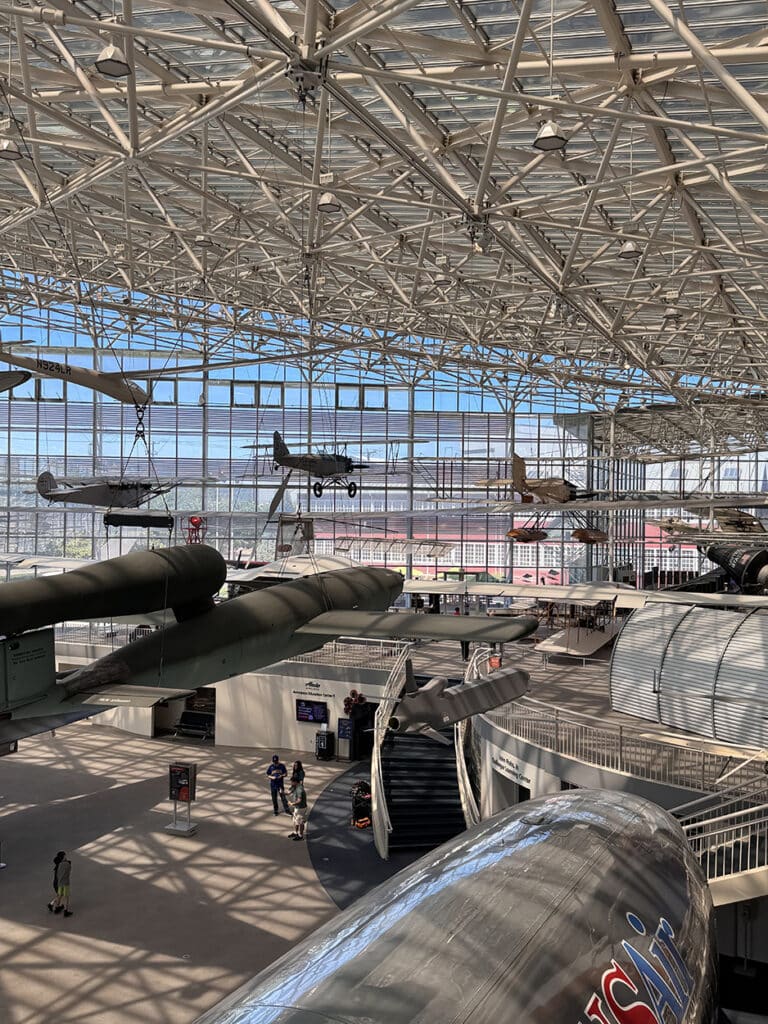
The Great Gallery.
The perimeter has exhibits on each level, but the center of the gallery is wide open. Since the top level is domed, planes hang from the equivalent of rafters. We were really very impressed.
Be sure to check out the second floor, which is primarily about the history of space travel. The historical aspects of each project are included in the exhibits. For example, we were able to look at and learn about the Apollo Command Module.
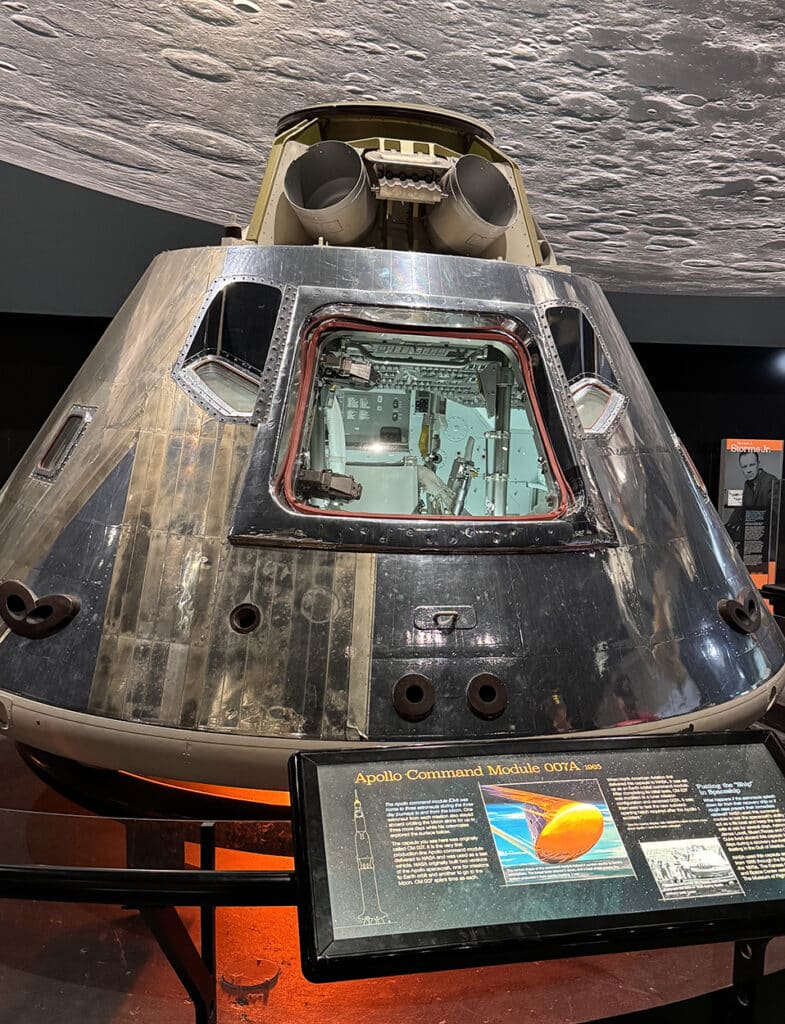
The Apollo command module.
Other displays honor the many individuals who have devoted much of their time and talent to our space program. Among them are Robert Goddard, Christopher Kraft, Harriet Johnson, and the Apollo astronauts.

In the far corner of the lower floor is a kid’s area that includes an interactive flight zone and a virtual reality simulator. There is an additional fee for the simulator.
Plan to spend at least an hour or two in the gallery. Once you have completed this area, make your way back to the lobby and then down the hall to the J. Elroy McCaw Personal Courage Wing.
The Library and Archives Building
This building was completed in 2002. The J. Elroy McCaw Personal Courage Wing opened in 2004. Here’s where you can learn all about the history of flight. Proving that the museum really does cover the full range of flight history, there is an exhibit that explains the aerodynamic elements of how birds fly.
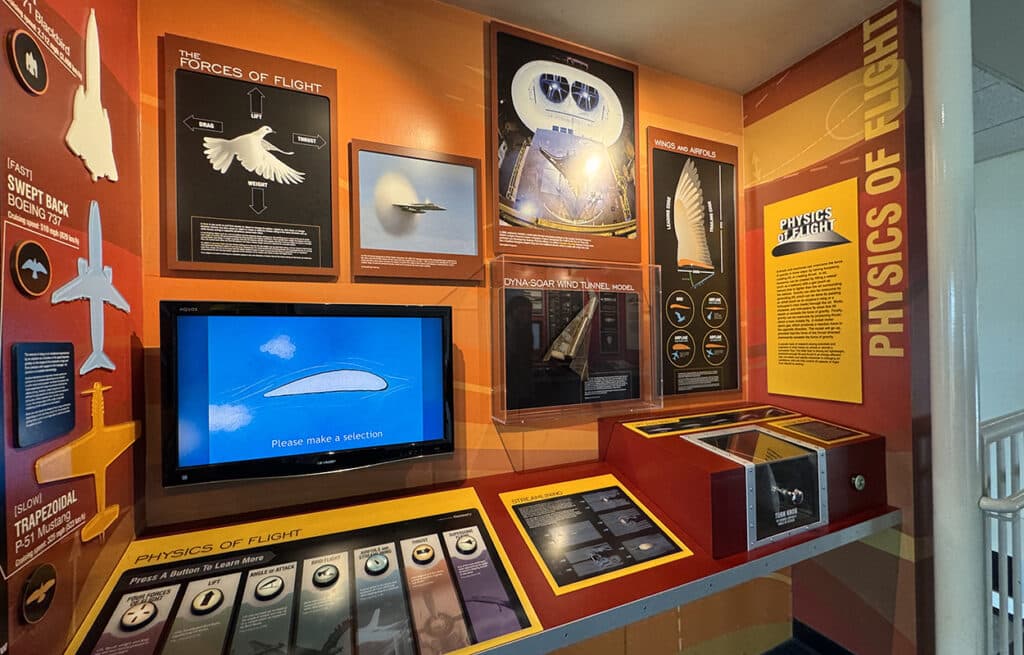
Birds fly, too. Photo by Mary Williams
Most of the exhibits in this wing create a compilation of the stories of the people who were involved with World War I and World War II air combat. The Personal Courage Wing is a two-story gallery that highlights their courage, dedication, and heroism. This 88,000-square-foot addition showcases 28 restored World War I and World War II fighter planes across two galleries, including the internationally known Champlin Fighter Collection.
Through state-of-the-art exhibits, interactive experiences, and flight simulations the exhibits tell the stories of not only those who flew, but the people who designed, built and maintained these amazing aircraft. A number of exhibits across the entire facility are designed to introduce kids to potential careers in aerospace and encourage them to pursue stem education.
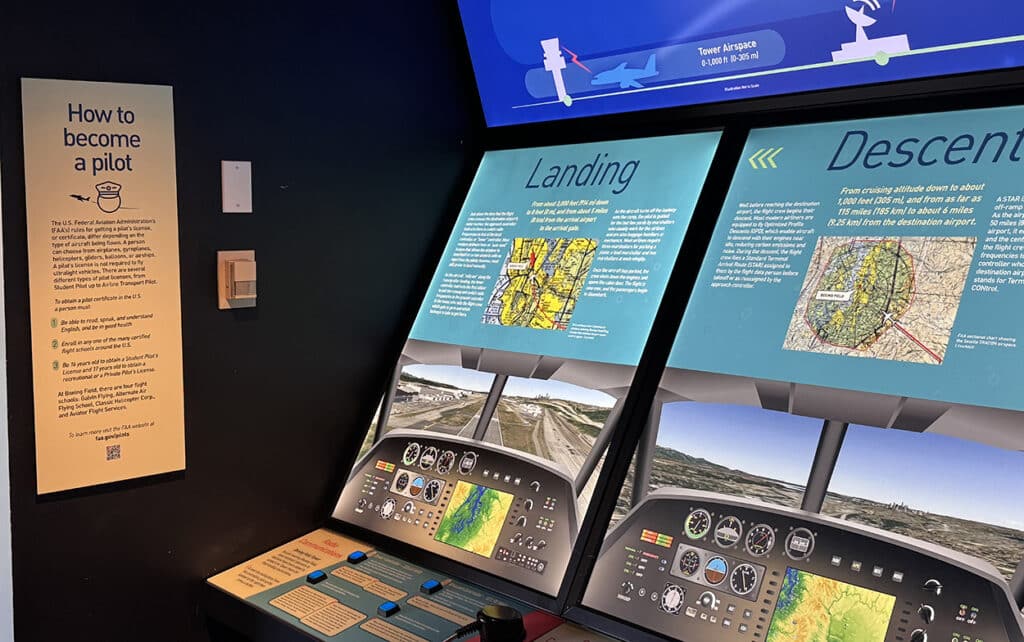
A STEM education display. Photo by Mary Williams
Unlike the museum’s Great Gallery, which is wide open and infused with light, the Personal Courage Wing is essentially a black box, designed to provide necessary protection from harmful ultraviolet light that can damage fragile items like documents and uniforms.
Victory Verticals Project
The last facility on this side of the street is the Red Barn which tells the story of the Boeing Company. It is also the home to the many museum exhibits that are of a temporary nature. Currently, it houses many of the exhibits and much of the information about the MiG-21 Project.
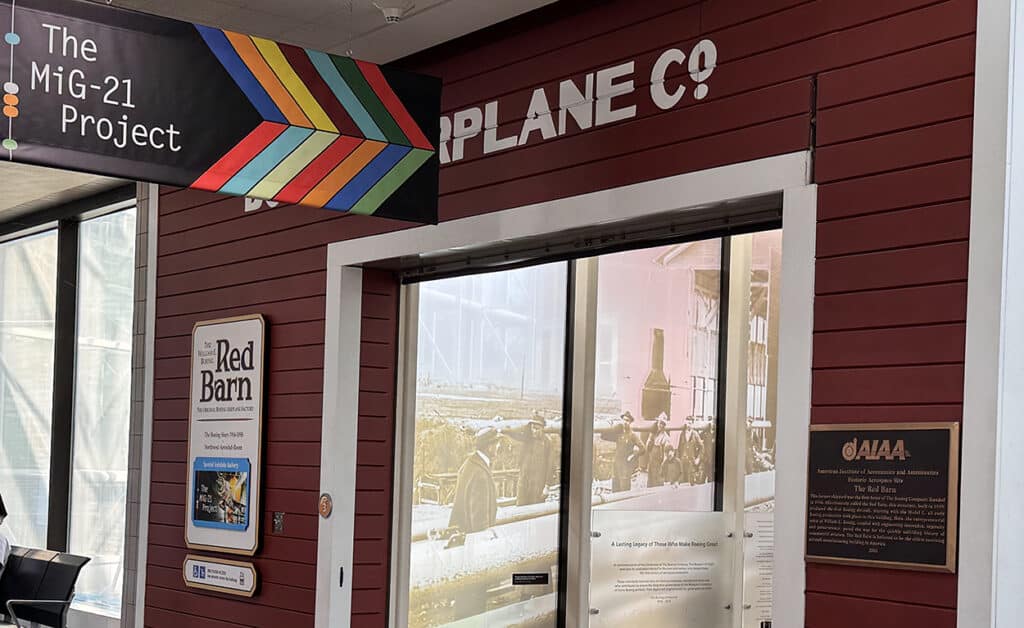
The Red Barn at the Seattle Museum of Flight. Photo by Mary Williams
A more recent addition is the Victory Verticals Project. You may have heard about it on the news over the past couple of weeks. This exhibit features three of the Steinway G.I. pianos, known as “Victory Verticals.” They are fully restored and tuned portable upright pianos that were built and shipped during WWII specifically to provide instruments and live music to troops on the front lines.
Over the course of the exhibit, special programs and displays will highlight how music allegedly helped win the war and will include regularly scheduled mini-concerts. You’ll really need to hustle if you want to see this exhibit or go to any of the concerts. It arrived on Aug. 8 and will be here for only one month.
I can’t do justice in the space I have to the different displays that explain the MiG-21 project. They are housed here in the Red Barn, and pretty much have to be seen in person to really comprehend the magnitude of the work and it cultural significance.
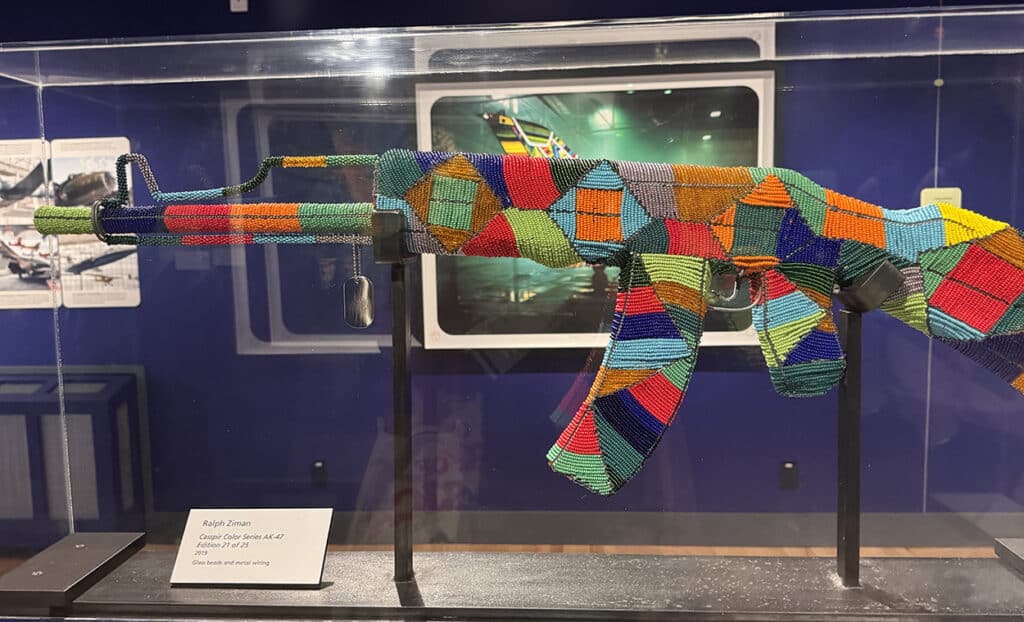
A beaded rifle at the Museum of Flight. Photo by Mary Williams
As we talked about the different things we saw, one concept really hit home for me. Wars are not always on a battlefield. All throughout history, wars have been fought on our streets, in our communities, and across all spectrums of society.
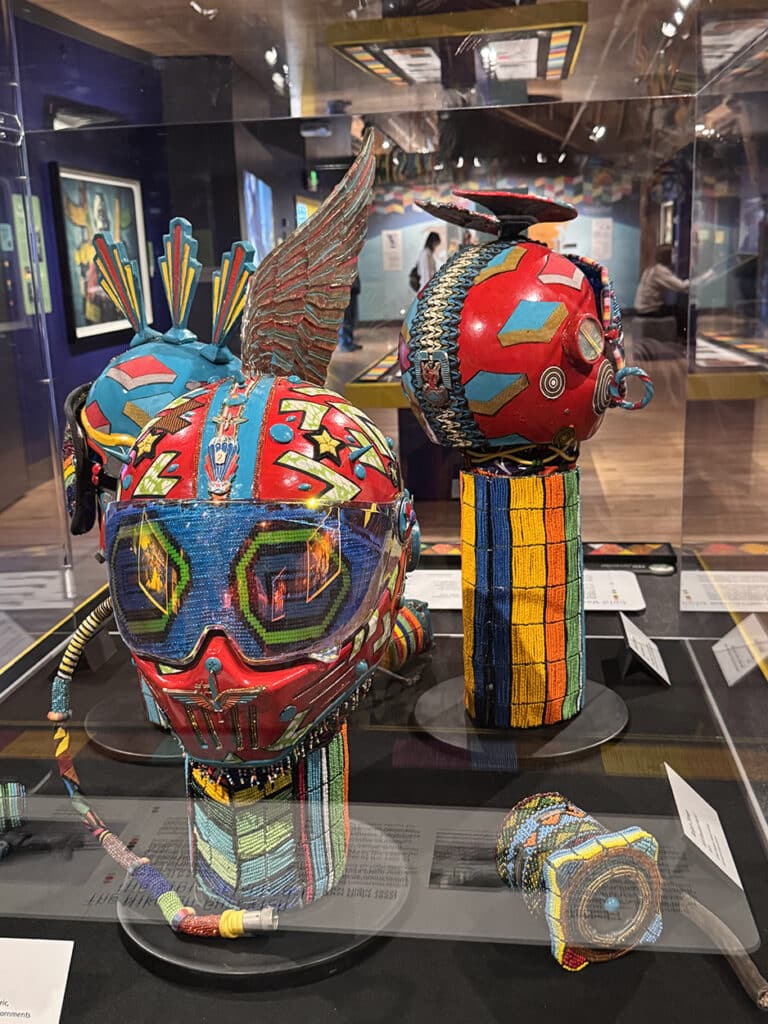
Beaded motorcycle helmets. Photo by Mary Williams
Just outside the entrance to the Red Barn is the skybridge to the west campus.
West Campus
The view from the bridge emphasizes the enormity of the Boeing complex. Block-long Boeing buildings, Boeing Field, office buildings, and planes, trains, and automobiles flank the museum campuses.
The Simonyi Gallery and Aviation Pavilion are located on the lower level and are accessible either by stairs or an elevator.
The Charles Simonyi Space Gallery was added to the existing facility in 2011, followed by the Aviation Pavilion in 2016. The museum added the 15,500-square-foot gallery, named after the former Microsoft engineer and two-time space traveler, which houses NASA’s Space Shuttle Full Fuselage Trainer, a full-scale wingless Space Shuttle replica used to train NASA astronauts. Also in the gallery is a Soyuz capsule in which Simonyi returned to Earth for the second time, which he has provided to the museum on a long-term loan.
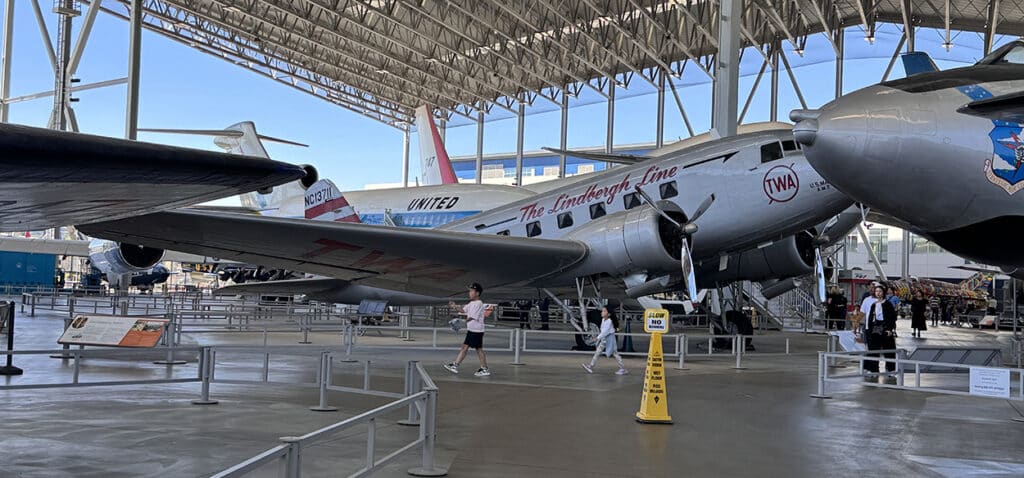
The Aviation Pavilion at the Museum of Flight. Photo by Mary Williams
This open-air building focuses on commercial flight. It is the home to many of the familiar Boeing planes. Several of them are open and can be toured. Among these is a retired Air Force One jet that transported several presidents.
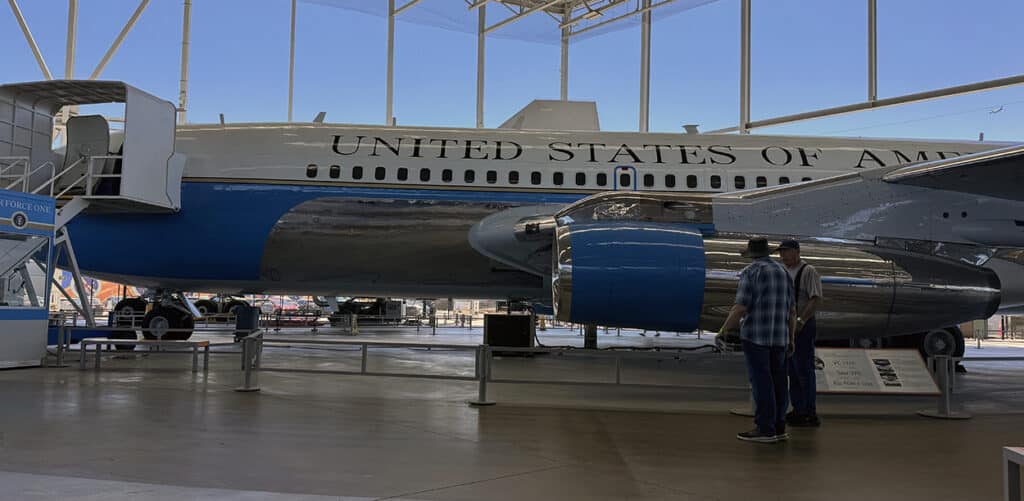
A retired Air Force 1. Photo by Mary Williams
Military aircraft
Another section displays the many different aircraft that have been essential to the spread of commerce across the country. They range from small aircraft that provided the initial airmail services to today’s United Parcel Service and FedEx jets.
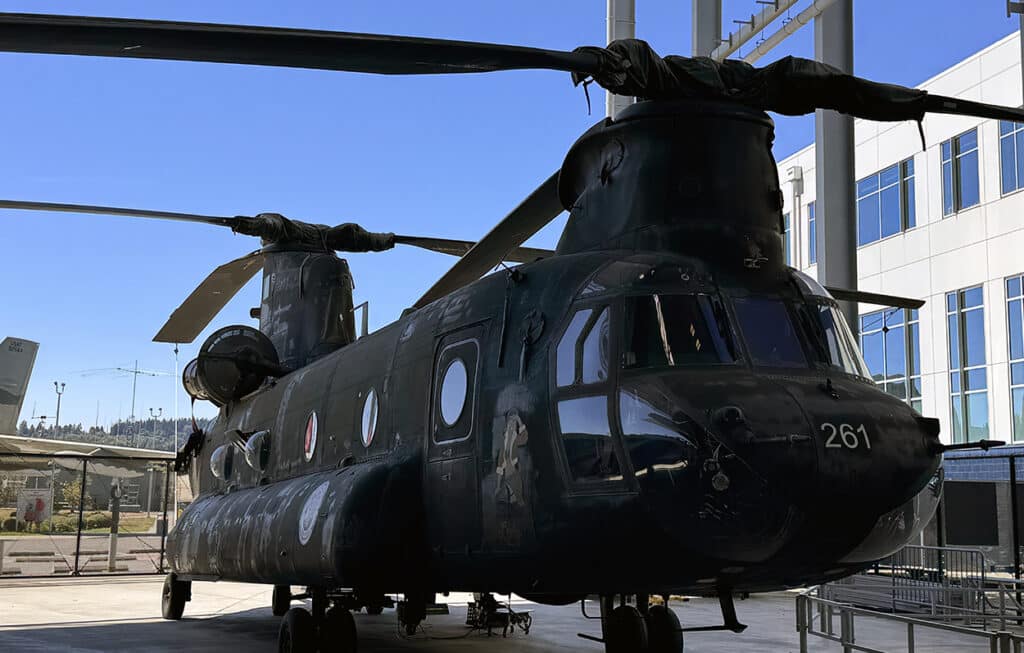
A Sikhorsky helicopter in the Aviation Pavilion at the Museum of Flight. Photo by Mary Williams
Another section houses current military aircraft, including a Sikorsky helicopter.
We were also able to see just how small the planes used by the Blue Angels are. This was particularly relevant because we were visiting the Museum during SeaFair and as we were looking at the plane, they were flying overhead.
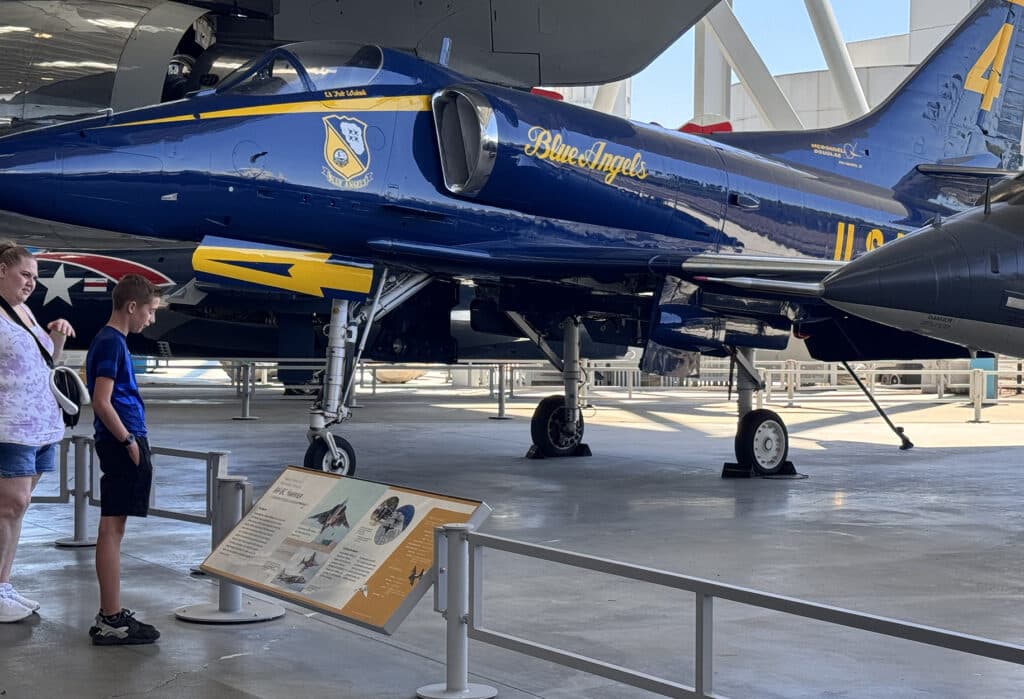
A retired Blue Angels jet.
And, finally, we arrived at our initial reason for visiting the museum, the elegantly beaded MiG-21.
If you think you’d like to cover your own MiG-21 with beads, there’s even an exhibit telling you how to go about doing it. It does not, however, tell you where or how you can acquire a MiG-21.
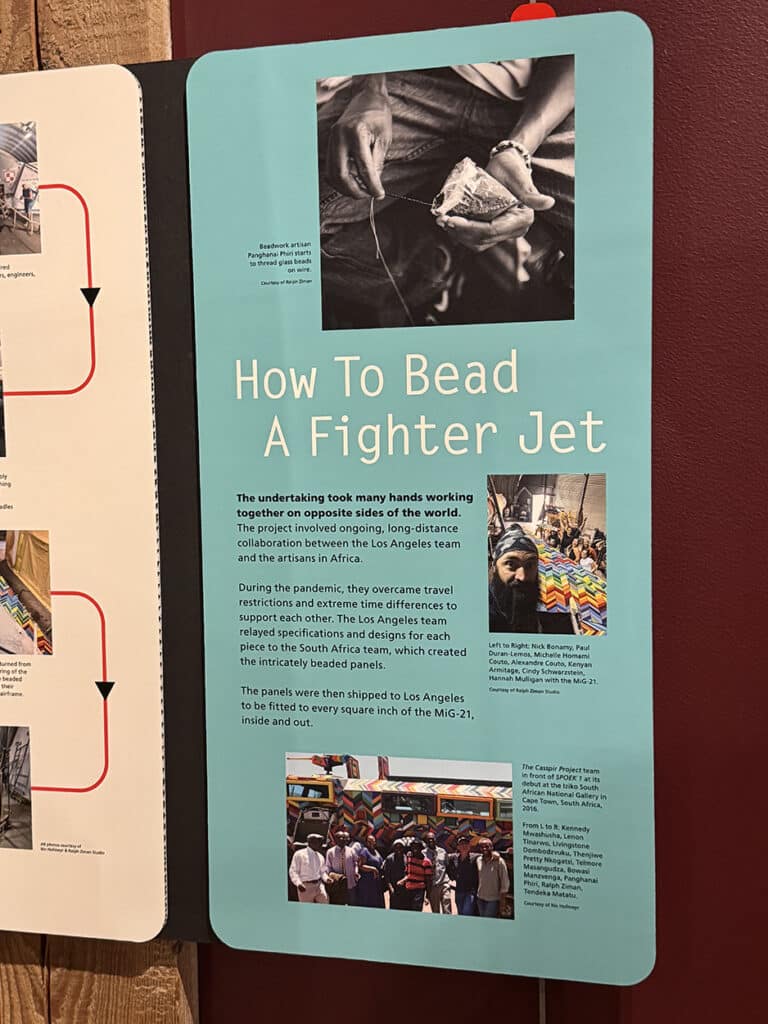
The exhibit opened on June 21, 2025. Its last day at the museum will be Jan. 26, 2026.
Finally, the museum website suggests that you drive to the Vietnam Veteran’s Memorial either before or after your visit to the museum. This compact little park is just outside the backside of the Aviation Pavilion, but there’s an ungated fence between them that prevents direct access. The park has benches and tables where you can sit and contemplate your surroundings.

The Vietnam Veterans Memorial Park at the Museum of Flight. Photo by Mary Williams
The Museum of Flight is located off I-5 at the south end of Boeing Field. Take exit 158 off the freeway. 9404 East Marginal Way South, Seattle.
About the Day Tripper column
Gas prices are sky high, and a night in a hotel is approaching astronomically expensive. So, for the foreseeable future, I imagine many of you are going to find yourselves taking day trips rather than the road trip vacations we’ve grown to love.
This beautiful region in which we live is ripe with opportunities to explore new places, see new things, and learn a little something at the same time. I promise to keep the longest journeys to a one-way distance of under 200 miles. Whether you want to make it an overnight trip, a weekend, or just a very long day trip, we should be able to pull it off.
I hope you’ll grant me the honor of your virtual company as we travel these roads together. Happy trails!

